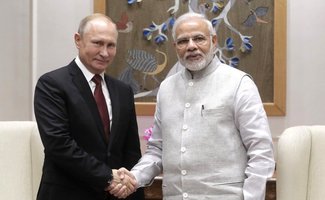At UP Factory, Kalashnikov To Make Successor To The Iconic AK-47

NEW DELHI:
AK 203 is the latest derivative of the legendary AK-47 rifle. India has signed a deal with a Russian firm to manufacture 750,000 of these assault rifles which would be given to the Army's infantry troops.
According to officials, the guns would replace the existing India-made INSAS assault rifles in the Army, Air Force and Navy.
After the rifles are supplied to the defence forces, the government, in the next phase, would provide them to paramilitary and the state police forces. There is a possibility that 15 to 20 years down the line, all the forces would be using this assault rifle as their standard weapon.
Apart from this, the Defence Ministry has already signed a contract with American Sig Sauer for the supply of 7.69mm 59 calibre advanced assault rifles. These would be given to soldiers directly engaged in counter-insurgency and other operations.
View: https://youtu.be/ms0HKC8kwuE
Vladimir Putin sent a message of greetings to participants and guests of the ceremony launching the Russia-India Kalashnikov assault rifle plant.
March 3, 2019
15:00
The message reads, in part:
“Military technical cooperation has traditionally been a key area of Russia and India’s special and privileged strategic partnership.
We have been delivering reliable and high-quality weaponry and equipment to our Indian friends for over seventy years. Around 170 military and production facilities have been launched in India with the help of our country.
This new joint venture will produce world-famous Kalashnikov assault rifles of the cutting-edge 200-series and will gradually shift to totally domestic production.
Thus India’s military industrial complex will be able to independently supply the country’s security agencies with this type of rifle armaments while implementing advanced Russian technologies.
Let us recall that I and my friend Mr Modi agreed on launching the Kalashnikov production plant during my official visit to India last October.
A respective intergovernmental agreement was promptly drafted and inked. In this connection I would like to sincerely thank those Russian and Indian specialists who helped to implement this project so quickly.
I am confident that launching this enterprise will contribute to enhancing India’s defence potential, the further advancement of the research and industrial foundation of the country’s economy, will allow for the creation of new qualified jobs, give impetus to vocational education and training of personnel, while the plant itself will become yet another symbol of friendship and fruitful cooperation between our countries.”

NEW DELHI:
AK 203 is the latest derivative of the legendary AK-47 rifle. India has signed a deal with a Russian firm to manufacture 750,000 of these assault rifles which would be given to the Army's infantry troops.
According to officials, the guns would replace the existing India-made INSAS assault rifles in the Army, Air Force and Navy.
After the rifles are supplied to the defence forces, the government, in the next phase, would provide them to paramilitary and the state police forces. There is a possibility that 15 to 20 years down the line, all the forces would be using this assault rifle as their standard weapon.
Apart from this, the Defence Ministry has already signed a contract with American Sig Sauer for the supply of 7.69mm 59 calibre advanced assault rifles. These would be given to soldiers directly engaged in counter-insurgency and other operations.
View: https://youtu.be/ms0HKC8kwuE
Vladimir Putin sent a message of greetings to participants and guests of the ceremony launching the Russia-India Kalashnikov assault rifle plant.
March 3, 2019
15:00
The message reads, in part:
“Military technical cooperation has traditionally been a key area of Russia and India’s special and privileged strategic partnership.
We have been delivering reliable and high-quality weaponry and equipment to our Indian friends for over seventy years. Around 170 military and production facilities have been launched in India with the help of our country.
This new joint venture will produce world-famous Kalashnikov assault rifles of the cutting-edge 200-series and will gradually shift to totally domestic production.
Thus India’s military industrial complex will be able to independently supply the country’s security agencies with this type of rifle armaments while implementing advanced Russian technologies.
Let us recall that I and my friend Mr Modi agreed on launching the Kalashnikov production plant during my official visit to India last October.
A respective intergovernmental agreement was promptly drafted and inked. In this connection I would like to sincerely thank those Russian and Indian specialists who helped to implement this project so quickly.
I am confident that launching this enterprise will contribute to enhancing India’s defence potential, the further advancement of the research and industrial foundation of the country’s economy, will allow for the creation of new qualified jobs, give impetus to vocational education and training of personnel, while the plant itself will become yet another symbol of friendship and fruitful cooperation between our countries.”
Last edited:



![ROFL2 [rofl2] [rofl2]](/xen/styles/default/xenforo/smilies.vb/035.gif)

![Cheers [cheers] [cheers]](/xen/styles/default/xenforo/smilies.vb/018.gif)
